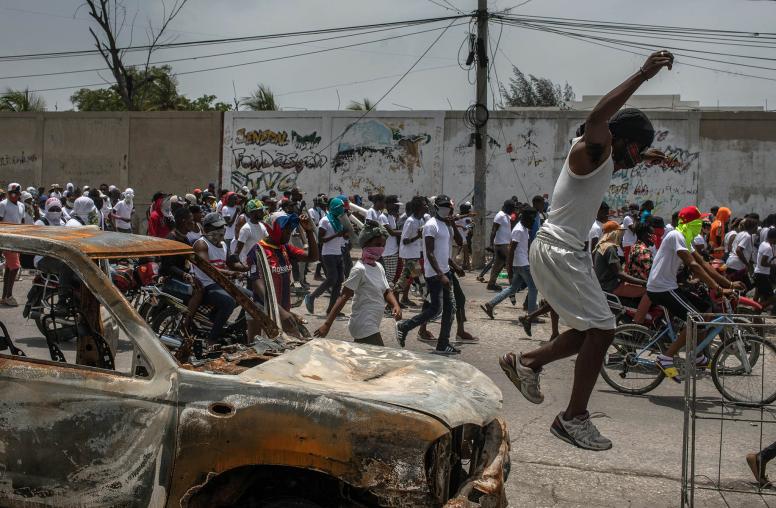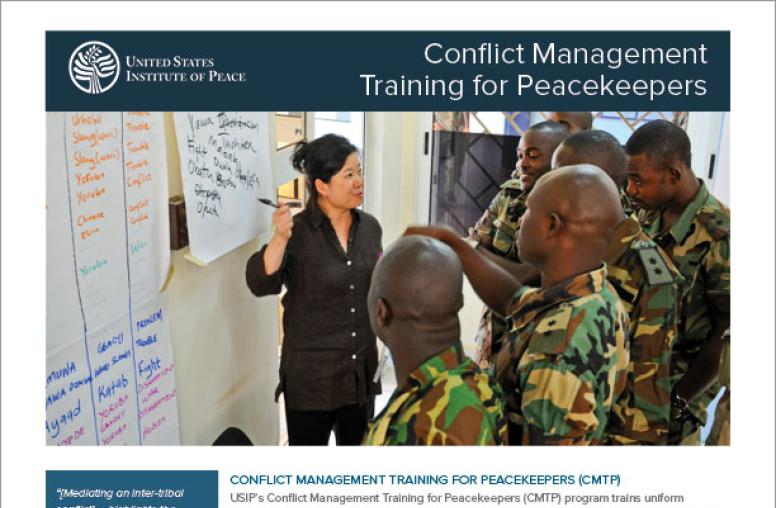Afghanistan’s Lesson: Strategic Costs of Civilian Harm
Protecting Civilians Is a Crucial Policy for U.S. Military, Report Says
After 15 years of U.S. military operations in Afghanistan, the strategic importance of avoiding harm to civilians is an inescapable lesson that policymakers need to fully integrate in American doctrine, planning and training, say the authors of a new report. The report offers “practical, pragmatic, concrete recommendations” to strengthen U.S. military operations overseas by averting losses to civilians and their communities, said former Undersecretary of Defense Michèle Flournoy in a public discussion at the U.S. Institute of Peace.
The United States harmed its mission in Afghanistan by failing to give a high priority to the protection of civilians during the first eight years of the war, according to the report, titled The Strategic Costs of Civilian Harm. That failure strengthened the Taliban insurgency and increased U.S. casualties say its authors, who described their findings last week at USIP. The study calls for a uniform policy to protect civilians, and for systems to collect and analyze data on civilian harm. It also urges the United States to insist on the protection of civilians by other, U.S.-backed, military forces in local conflicts.
“At the strategic level, too often we forget to pause and reflect, to digest and learn.” – Michèle Flournoy, former under secretary of defense for policy
“We learned that civilian harm is broader than casualties,” said Christopher Kolenda, who served four tours in Afghanistan and drafted a seminal reassessment in 2009 of American strategy under General Stanley McChrystal. Looking at the war through Afghan eyes, he said, he understood that “harm” includes the adverse effects of military operations on families, communities and the economy. “We were mobilizing people toward the insurgency; that is a strategic impact,” he said.
The lessons from Afghanistan should be applied to the U.S. roles in conflicts such as those in Yemen, Iraq, Syria and Pakistan, according to the report, which was produced by the Open Society Foundations. Rachel Reid, another of the study’s three authors, said Saudi Arabia is violating the laws of war in its U.S.-supported intervention in Yemen. And, she said, the United States is paying too little attention to effect of its linkage to those violations.
In Yemen and in Iraq, where the U.S. is carrying out airstrikes aimed at Islamic State fighters and giving support to Kurdish fighters, “we don’t know the scale or impact of civilian harm by the U.S. or its partner forces,” Reid said. She noted the U.S. military’s claim that only 41 civilians have been killed during 9,000 airstrikes in Syria and Iraq, an assertion she said is “incredible at the moment.”
Low-Cost Corrections
Setting up specialized data-collection units under a uniform military policy is key to achieving the low-cost, high-payoff benefits of civilian protection in counter-insurgency and counter-terrorism efforts, said Chris Rogers, the third author and a senior policy analyst at the Open Society Foundations.
“The lesson we discovered from Afghanistan is that we don’t know what we don’t know,” Rogers said. By teasing apart data on situations where civilian harm occurred, commanders might learn whether to use—or avoid—certain weapons, or whether a given escalation of force, and risk to civilians, would fit into a strategic plan. U.S. forces should standardize protocols for collecting and tracking data on harm to civilians—and should distribute the data to commanders at every level in a campaign, he said.
Kolenda, who helped then-Under Secretary of Defense for Policy Flournoy develop a new U.S. strategy for the Afghan conflict, said he came to the issue of civilian protection in an intensely personal way. In 2007-2008, he was commanding an airborne infantry task force in Kunar and Nuristan provinces when four of his soldiers, including a close friend, were killed in major firefights. He said he began thinking more deeply about who the enemy was. Then he began to investigate.
“The more I dug, the more I realized civilian harm was the critical catalyst for why we faced these threats,” he said.
Kunar: A ‘Public Insurrection’
Kolenda said he eventually learned that an Afghan close to the U.S. forces had provided them false intelligence linking a local elder, with whom the Afghan had a running blood feud, with the Taliban. When U.S. forces targeted the alleged Taliban supporter, he fought back with support from his community. Residents backed him against the Americans in part because of the accused leader’s stature and in part because of other harm U.S. forces and their allies had done to civilians. According to the report, the U.S. forces had shattered the “ecology of civilian life,” with arrests or killings of family breadwinners, with home searches and other offenses against local honor traditions, and with the corruption of local officials under umbrella of U.S. power.
“The damage accumulated to the point that we had a public insurrection,” Kolenda said, stressing that the problems all occurred even while U.S. troops rigorously adhered to the laws of armed conflict.
Subsequently, Kolenda wrote in his foreword to the 84-page report, the insurgents stopped fighting after contacts were made with local elders and the accused leader made peace with the Afghan government. Kolenda said he has since met with his former adversary eight times.
The report calls for developing “intelligence priorities to collect and analyze the political, economic, social, and cultural dynamics of host nations in conflict zones and their effects on U.S. policy and strategic aims.” That effort should assess and avoid the risk of being manipulated by local officials and elites, with the resulting strategic impact of civilian harm, according to the report.
Researchers on the report found no evidence that concern for civilian harm created additional risk for U.S. troops, Reid said. U.S. and NATO forces were responsible for 39 percent of fatalities in 2008, according to annual statistics gathered by the U.N. mission in Afghanistan—but only 9 percent in 2012 after McChrystal changed the U.S. forces’ policy. The drop coincided with a surge in troop numbers, she said. Allied fatalities, as a percentage, didn’t increase. The Taliban, meanwhile, continued to use largely indiscriminate, low-precision weapons, she said.
A Loss of Focus
To a question from the audience, Flournoy said her experience in government suggests to her that, once the United States deploys its armed forces to confront a crisis, it loses focus on critical, non-military aspects of the problem.
“When we use the military instrument in a major way, as in Afghanistan, we tend to understandably focus, in a very fine grain, on the details of the military aspects of the campaign,” said Flournoy, who is now CEO of the Center for a New American Security. “And too often that becomes the shiny object in the inter-agency discussions and we spend too little time discussing” issues that can be addressed by “other instruments of power.”
Of non-military aspects of a crisis, Flournoy said, “we tend to not pay enough attention to those elements of strategy, but we also, as a government, as a nation, don’t fully resource those instruments.”
“I’ve watched a number of integrated plans, whether it was in Iraq or in Afghanistan, be beautifully designed and integrated, and then sent up to the Hill for funding, and they come back with the military piece 100-percent funded and the diplomatic and development pieces grossly underfunded, and so the whole plan sort of falls apart, or is sub-optimal,” she said.
Flournoy praised the report as a potential corrective. “At the strategic level, too often we forget to pause and reflect, to digest and learn,” she said.



